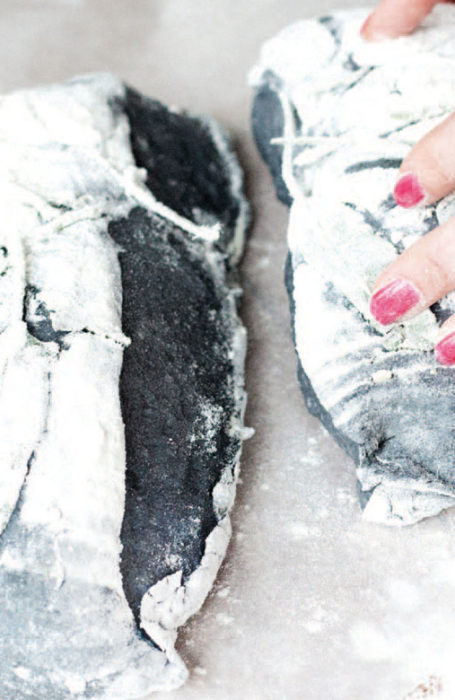“This bread, with its crust covered in sage leaves for decoration, has become the signature bread for the Bread Exchange. This is the bread I bake the most and it is often requested as trades.
It is the most beautiful colour for a slice of salmon, a beet mousse, or practically any jam. I like that the charcoal powder does not substantially change the taste of the simple sourdough.
Some traders say they taste no difference, some say they do. I think the charcoal lessens the sourness of the bread a tiny bit. However, the blind tests I’ve done with traders seem to show that the black colour only makes us imagine a difference in the bread’s flavour.
You can find edible charcoal powder at natural foods stores and online.”
Serves
Makes 2 loaves
Cook Time
40 minutes
WHAT YOU NEED
½ cup/100g wheat-flour
Sourdough starter
1 ¼ cups/300g lukewarm water (around 40°C)
3 cups plus 3 tbsp/400g organic unbleached all-purpose flour
2 tsp/1g salt
¼ cup/25 g rice flour
¼ cup/30g any wheat flour
1 tsp edible charcoal powder
2 tsp any alcohol in your bar, such as rum, vodka, or even water
Large leaves from 2 sage stems
WHAT TO DO
Note: Australian Baking Business assumes its readers know how to mix, fold, rise, shape and bake sourdough. The method below is a simplified extract from The Bread Exchange. For the full recipe, contact Hardie Grant Books
Simple Sourdough Recipe:
1. Mix the starter, water, and all-purpose flour in a large bowl. Cover with plastic wrap and let the dough rest for 30 minutes to 1 hour.
2. Sprinkle the salt over the dough and fold the dough four times or until the salt is well distributed and the surface of the dough is starting to feel a bit taut. Let the dough rest for 30 minutes to 1 hour and then fold again. Once again, let the dough rest for 30 minutes to 1 hour, and then fold again and let rest two to three times during the next 2 to 3 hours, covering the dough during each resting period. After the final folding, let the dough rise at room temperature (no warmer than 18°C) for 4 to 6 hours.
3. Test the dough to see if it is ready to bake by gently pressing your fingers into the surface to see if it is taut and if your fingers leave a small hollow. If the dough is ready to bake, place a linen cloth on a flat surface. Combine the rice flour and wheat flour in a small bowl and sprinkle the mixture on the cloth. Turn out the dough onto the floured cloth. Fold the dough four times. Repeat three times, for a total of twelve folds.
4. Transfer the dough on the cloth to the proofing basket and cover with a clean cloth. Let the dough rise at room temperature for 1 to 4 hours, or in the refrigerator for 8 to 10 hours, or longer, as needed.
5. When the dough has risen and will soon be ready to bake, place a baking stone or baking sheet on the lowest rack in the oven, set an old baking pan on the oven floor, and preheat at 250°C for 40 minutes.
6. Put a piece of parchment paper on a baker’s peel. Turn the dough out onto the parchment paper and divide the dough into two pieces. If you wish, slash the loaves.
7. Slide the dough and parchment paper onto the preheated baking stone. Pour about 120ml water into the baking pan on the bottom of the oven. For a dark, caramelised crust, leave the oven temperature at 250°C. For a crust lighter in colour, after the first 10 minutes of baking, lower the oven temperature to 220°C.
8. After 20 minutes, check the loaves for even browning and turn them front to back. For even browning, turn the loaves again 10 minutes later. After 40 minutes, remove one loaf and tap the bottom. If you hear a hollow sound, the loaves are ready. If the bread sounds dense, return it to the oven and retest in 5 minutes, and again in 5 minutes, until you hear that hollow sound. Set the loaves on a wire rack to cool. When the loaves are at room temperature, they are ready to be sliced. The loaves will keep, unsliced and stored in a paper bag, at room temperature for 2 to 3 days.
Adding the Charcoal:
In a small bowl, mix the charcoal and alcohol together. Prepare and bake the dough as directed, mixing the charcoal-alcohol mixture in with the water and arranging the sage leaves over the tops of the loaves. Bake as directed.






COMMENTS